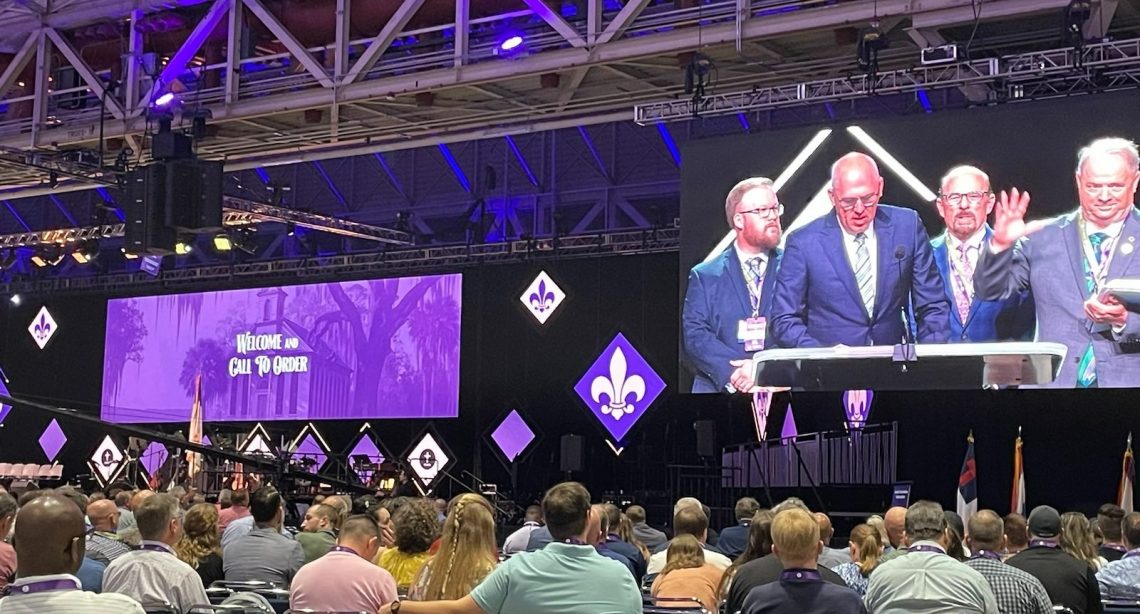The annual meeting of the Southern Baptist Convention (SBC) is now in the books, and this one was pretty epic. The reason we exist as a denomination is to partner together for the purposes of the Great Commission. Which is just another way of saying that we believe that like-minded believers can reach more people for the gospel and train more ministers for the work if we pool our resources together. That is what we have been doing for over a century and a half, and that is what we are doing now. That’s why the sending ceremony for our missionaries encapsulates for everyone every year why we do what we do. As President Bart Barber said on Tuesday, “This is the business of the convention.”
Overall, I think the messengers made good decisions this week, and that is good. But there were also some things that will require our vigilance going forward. Here are some of the major developments and my thoughts on them:
1. Saddleback, Fern Creek, and Freedom Church Removals. Messengers voted to sustain the removal of these three churches from our convention, and the votes were decisive. As in, not even close. Saddleback and Fern Creek were both removed for having female pastors. Freedom Church was removed from the Florida State Convention last year for having a disqualified male pastor and now from the SBC for failing to cooperate into an abuse inquiry about that pastor. The votes show that Southern Baptists aren’t confused about their complementarian commitments or about female pastors. They also show that you don’t have to choose between complementarianism and abuse reform. We can do both, and we did.
Here’s the debate between Rick Warren and Albert Mohler about Saddleback’s removal from the SBC. Ballots are being taken now. Results later.#SBC23 pic.twitter.com/XVHND3ki8l
— Denny Burk (@DennyBurk) June 13, 2023
The messengers of the SBC have voted to sustain Saddleback’s removal from friendly cooperation. The vote was overwhelming.
Virtual silence after the result was announced.#SBC23 pic.twitter.com/tiIb2Gz6Tz
— Denny Burk (@DennyBurk) June 14, 2023
2. Mike Law’s Amendment to the Constitution. Coming into the convention, I really thought this effort was a longshot. The Executive Committee advised messengers to vote against the measure, but the messengers ended up rejecting that advice. And they did so overwhelmingly. It takes a two-thirds vote, and about 80 percent of the messengers raised their ballots in favor of the amendment. It was so overwhelming that the chair didn’t even have to call for a ballot vote. I am still stunned at how decisive this result is. But it’s not over yet. Constitutional amendments require two-thirds majority votes over two consecutive years. So we have to run this back and complete things in Indianapolis next year. All eyes on Indy until then.
What was the rationale for this amendment? Some people mistakenly understand the word “pastor” to mean “senior pastor” in the BF&M. As a result, they believe that women should be allowed to serve as pastors so long as they are not the senior pastor. This amendment would slam the door on that misinterpretation and clarify that the office of pastor/elder/overseer is only for men as qualified by scripture.
Here are my full remarks speaking in favor of the Law Amendment at the SBC Annual Meeting. #SBC23 pic.twitter.com/GVnvFnszl5
— Denny Burk (@DennyBurk) June 16, 2023
3. An Amendment to the BF&M. At this convention, we bade farewell to the BF&M 2000 and replaced it with the BF&M 2023. I know I’m being a little grandiose, but we really did revise the BF&M. And it is probably the most underreported and surprising action that happened at the annual meeting. We voted to change Article 6 of the BF&M by adding the words “elder” and “overseer” to the word “pastor.” The lines now read this way:
“In such a congregation each member is responsible and accountable to Christ as Lord. Its two scriptural offices are that of pastor/elder/overseer and deacon. While both men and women are gifted for service in the church, the office of pastor/elder/overseer is limited to men as qualified by Scripture.”
Some months ago, the senior pastor of Saddleback argued that pastor is a gift not an office. While women have the gift of pastoring, they may not serve in the office of elder/overseer. In this way, Saddleback has effectively created two offices of leadership in the church. The Convention slammed the door on that misinterpretation as well by adopting this amendment. A pastor is an overseer is an elder, and only qualified men can serve in that office. (The convention also passed a resolution doubling-down on this very same point.)
I have to say that while I agree with the theology of this amendment and am grateful for it, I do not agree with the precedent of this amendment. Our governing documents make it far too easy to amend the BF&M. We need to change this so that amendments to the BF&M take two years, just like it does with amendments to our Constitution and Bylaws. I hope a change like that is forthcoming.
3. The Election of Bart Barber. Bart Barber won a second term in a contested election. The fact that it was contested is very unusual. By tradition, we typically allow our presidents to run unopposed for a second term. But Mike Stone decided to run against Barber with a different vision concerning how to do Abuse Reform. In the end, Barber carried the day overwhelmingly. Congratulations to Barber on this. Heath Lambert has some helpful reflections on what it might mean that about a third of the messengers voted for the challenger. He writes:
Over the next year, the 68% of people who voted for Barber must treat the 31% who did not with respect. One-third of our convention is not crazy or out of touch. They are brothers and sisters in Christ who see things differently than the majority, and we need each other. On the other hand, the 31% who did not win must be careful not to withdraw from convention life and accuse those with whom they disagree of being liberal or faithless. They are our brothers and sisters in Christ, and we need each other.
Amen to that. We need to stay together.
4. The Renewal of the Abuse Reform Implementation Task Force (ARITF). I don’t think this vote was ever in doubt. Southern Baptists have been voting overwhelmingly and consistently in favor of abuse reform for several conventions now. It shows that the SBC’s clear and manifest complementarianism is not at odds with a commitment to abuse reform. Despite the naysayers, we can do both at once, have been doing both at once, and will continue to do so for the foreseeable future.
5. The Appointment of a New Task Force to Study the SBC’s Constitution. Some former SBC presidents proposed a task force to study the SBC Constitution with an eye toward defining what role the BF&M plays in defining “friendly cooperation” in the SBC. The task force may recommend changes to define how much or how little of the BF&M a church is allowed to contradict and still be in friendly cooperation. This task force could end up making recommendations that would nullify many of the complementarian gains described above. Maybe they won’t end up making such a recommendation, but those outcomes are definitely on the table. I guess we’ll see over the next year.
6. The Resolution against so-called “Gender Affirming Care”. The resolutions committee accepted the resolution that Andrew Walker and I submitted. They changed it a good bit, but the final result is okay. I’m glad to see it come out. The convention voted in favor of it overwhelmingly. Here’s the final text.
Overall, I would say that the messengers to the SBC doubled-down on conviction this year. In particular, they declared with an unambiguous voice that we are still complementarian and that isn’t changing anytime soon. I couldn’t be more grateful for that result.






